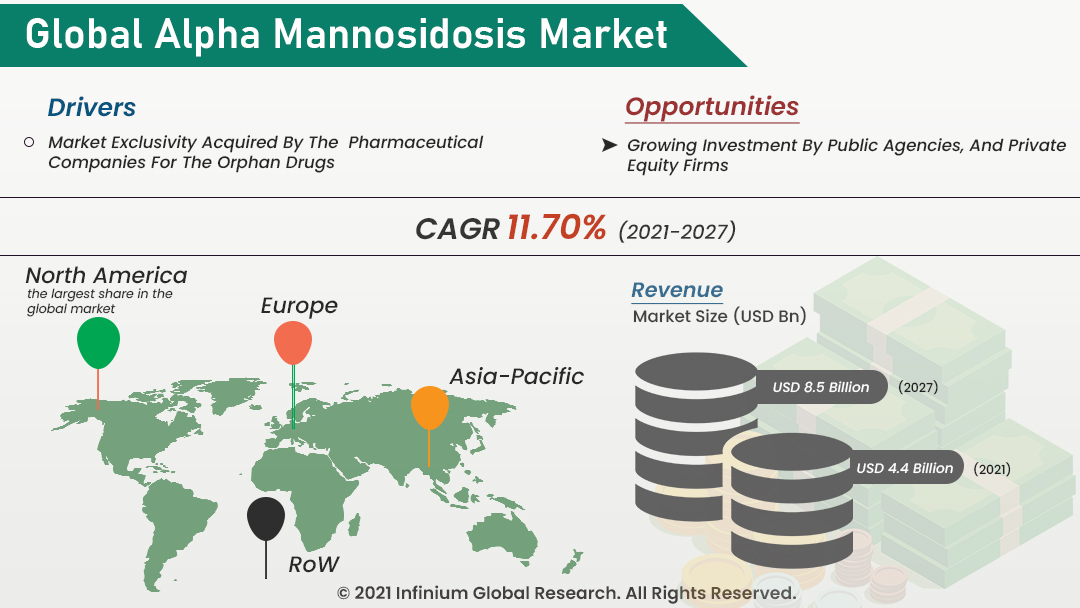Alpha Mannosidosis Market (Indication - Type I, Type II, and Type III; Treatment - Bone Marrow Transplant (BMT), and Enzyme Replacement Therapy (ERT); End User - Hospitals, and Specialty Clinics): Global Industry Analysis, Trends, Size, Share and Forecasts to 2027
A recent report published by
Infinium Global Research on alpha mannosidosis market provides in-depth
analysis of segments and sub-segments in the global as well as regional alpha
mannosidosis market. The study also highlights the impact of drivers,
restraints, and macro indicators on the global and regional alpha mannosidosis
market over the short term as well as long term. The report is a comprehensive
presentation of trends, forecast and dollar values of global alpha mannosidosis
market. According to the report, the global alpha mannosidosis market is
projected to grow at a CAGR of 11.7% over the forecast period of 2021-2027,
growing from nearly USD 4.4 billion in 2021 to about USD 8.52 billion in 2027.

Market Insight
Rare genetic disorders are been
studied across the world to find their treatment and precautionary measures to
avoid the incidence. Alpha mannosidosis is one of the rare genetic disorders,
which is a type of group of diseases known as lysosomal storage disorders.
Alpha mannosidosis is a rare disease that occurs in 1 in every 500,000 people.
The deficiency of the enzyme alpha-D-mannosidase results in alpha mannosidosis.
The patients suffering from alpha-mannosidosis vary in symptoms, progression,
and severity from one person to another. Moreover, many researchers are
studying the disorder to find an effective treatment for it. Bone marrow
transplant (BMT), and enzyme replacement therapy (ERT) are the two most commonly
used therapies for alpha-mannosidosis. Other treatments such as peripheral
blood stem cell transplantation are also been studied for alpha-mannosidosis.
The spread of novel coronavirus
had a fairly negative impact on the global alpha mannosidosis market over a
short period. The healthcare, pharmaceutical, and other related industries
faced tremendous pressure during the period of pandemics. An increasing number
of COVID-19 patients overwhelmed the healthcare facilities such as hospitals
and clinics. Almost all the resources in these facilities were diverted to
managing the pandemic. This, in turn, resulted in neglecting the patients with
other less fatal health conditions including genetic disorders such as alpha
mannosidosis. Moreover, several public and private healthcare agencies focused
their funding on combating the pandemic crisis. This caused lower availability
of funds for health conditions other than Covid-19. However, as the Covid-19 cases
decrease, the healthcare service providers are expected to focus on non-Covid
cases with different health issues. This, in turn, is anticipated to boost the
market growth in the post-pandemic period.
The market exclusivity acquired by
the pharmaceutical companies for the orphan drugs is majorly driving the market
growth. The market exclusivity gives the companies incentive of several years
during which they can market their drug without the competition of duplicate or
reformulated products. Drugs for rare genetical disorders such as alpha
mannosidosis are considered orphan drugs that receive market exclusivity.
Moreover, monetary incentives by the governments for orphan drugs further
augment the growth of the alpha mannosidosis market. Orphan drug manufacturers
are qualified to claim tax credits on R&D costs. They also receive fee
waivers from FDA and other regulatory bodies for the approval processes.
However, the price of orphan drugs is still higher as compared to other
generic, and branded therapies. This, in turn, is anticipated to hamper the
market growth of the alpha mannosidosis market. Nevertheless, growing
investment by public agencies and private equity firms is likely to offer
growth opportunities to the market over the forecast period.
In terms of region, the global
alpha mannosidosis market is segmented into North America, Europe, Asia
Pacific, and the Rest of the World. Among these regions, North America held the
largest share in the global alpha mannosidosis market. the domination of North
America was mainly attributed to the higher number of clinical trials conducted
in the region. Moreover, the development of orphan drugs has increased in the
region owing to various government interventions such as the Orphan Drugs Act
passed by the US federal government. Due to such government policies, many
orphan drugs are getting approvals from FDA and other regulatory bodies.
Furthermore, Asia Pacific is anticipated to grow with the fastest rate among
the regions in the global mannosidosis market. The market growth in Asia
Pacific is due to the number of initiatives by the governments to increase
awareness regarding rare genetic diseases, and their treatments.
Segment Covered
The report on the global alpha
mannosidosis market covers segments such as indication, treatment, and end
user. On the basis of indication, the sub-markets include type I, type II, and
type III. On the basis of treatment, the sub-markets include bone marrow
transplant (BMT), and enzyme replacement therapy (ERT). On the basis of end
user, the sub-markets include hospitals, and specialty clinics.
Companies Profiled:
The report provides profiles of
the companies in the market such as Chiesi SAS.
Report Highlights:
The report provides deep insights
into the demand forecasts, market trends, and micro and macro indicators. In
addition, this report provides insights into the factors that are driving and
restraining the growth in this market. Moreover, The IGR-Growth Matrix analysis
given in the report brings an insight into the investment areas that existing
or new market players can consider. The report provides insights into the
market using analytical tools such as Porter's five forces analysis and DRO
analysis of the alpha mannosidosis market. Moreover, the study highlights current
market trends and provides forecast from 2021-2027. We also have highlighted
future trends in the market that will affect the demand during the forecast
period. Moreover, the competitive analysis given in each regional market brings
an insight into the market share of the leading players.
